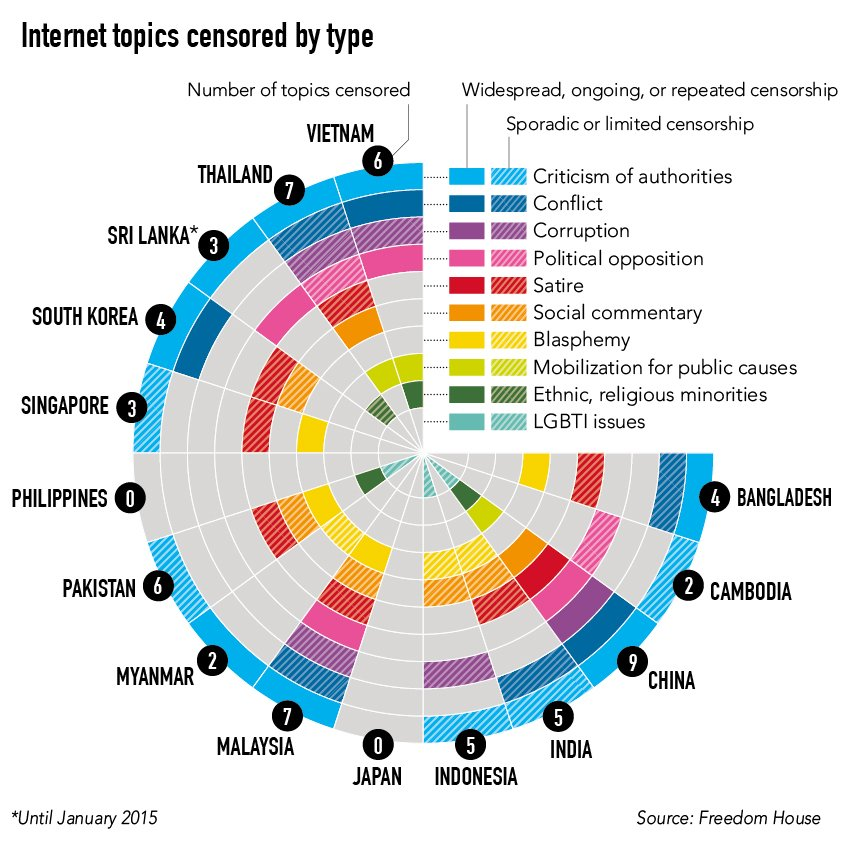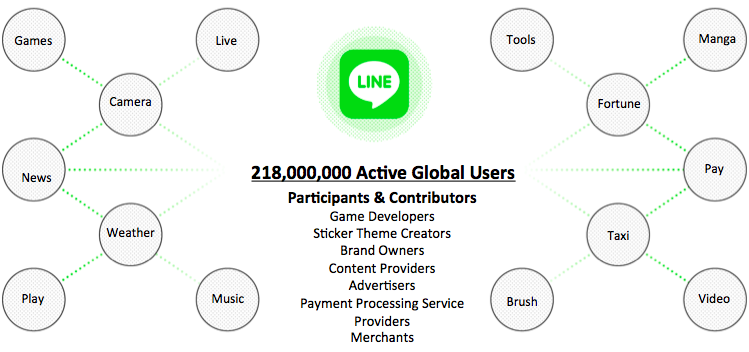The majority of the 4 billion people living inside a circle encompassing China, India, NE Asia and SE Asia—over half the world’s population—have not yet grasped the internet, but most of them will have within the next decade or two. How they do so, on what terms, and through which platforms, will go a long way to defining the winners and losers of the next wave of the web, and actually the very nature of the internet itself. So can we ask the question: how well placed are Silicon Valley companies to benefit?
The battlefield is a diverse patchwork of countries with distinct languages and cultures, varying degrees of connectivity infrastructure, diverse digital media landscapes, and contrasting political regimes with business environments that range from: mature but essentially open (Japan), barely connected and hence, in theory, up-for-grabs (India), effectively protected (South Korea), and outright walled off (PRC).
Against this vast and diverse tapestry of peoples and places, one of the biggest challenges for Silicon Valley folks is that not enough of them would find the title of this article absolutely preposterous. Having lived in “Asia” for 14 years, I find the very idea of Western minds attaching a single word to everything bundled into this mega-region increasingly absurd.
As I think the following case histories suggest, despite the relative ease with which the dematerialised nature of the web has allowed Silicon Valley’s star companies to scale-up faster than any others in history (Google became the world’s most valuable company in under 19 years), in order to play a big role in the future of the web in Asia, these companies will need to differentiate, decentralise and delegate control like never before, and hence become truly global in nature. Some will manage this feat, others will not, and we have already got some good evidence to suggest which they might be.
China’s Walled Garden
In Europe, Google has attempted to position itself as a “Growth Engine”, a vital and benign component of an industrial and cultural ecosystem that will create new business opportunities, innovation and, with them, much-needed new jobs and prosperity. In a continent that is going through its own “lost decade” that might well persist much longer, it seems like a well-tuned message to the bureaucrats in Brussels who seek to limit Google’s dominance through anti-monopoly rulings and punitive tax bills, but, whether this argument works in Europe or not, it is clear it would never work as a one-fits-all stance in Asia.
In China, for one, the CPC’s legitimacy to govern is in all practical terms the promise of continued economic growth, so you can imagine how they might react to Google attempting to assume a similar position. Of course, the CPC made this thought experiment academic by forcing Google’s hand on censorship, leading to Google—you have to say, to its credit—pulling out of China back in 2010, feeling that to remain would compromise its “Don’t Be Evil” corporate philosophy.
In the context of Asia’s emerging digital economies, and with Google’s growth engine claim in mind, the case for limiting the influence and power of global players to allow a healthy culture of local entrepreneurship to emerge and with it locally owned businesses is by no means illogical or counter-factual. Again in China, where protectionism has been overt, the likes of Baidu, Tencent (WeChat), Weibo and Alibaba are dominating similar spaces that Google, WhatsApp, Twitter / Facebook and Amazon occupy respectively elsewhere.
The reality is that despite the extraordinary wave of Globalism that has proceeded since the 1990s, Asia’s spectrum of “regimes” still each need their own careful strategy that achieves cooperation without being collusive. And with America itself having elected its own “regime” recently, this need to have a regime-strategy may have come home.
Korea’s Protected Park
The price of protectionism has always been the fact that companies sheltered at home are unable to compete beyond the barriers erected to protect them, and so far China’s own web giants have confirmed, rather than countered, this pattern; although M&A activity by Alibaba in particular is at least diversifying their portfolio.
Although South Korea is no China, it is effectively protected by its unique language, relatively small size (50m population)—meaning that there is usually a more alluring prize (bigger fruit, or lower-hanging) to chase for global corporates—and, less passively, a government that makes it extremely hard for foreign companies to operate comfortably.
The continuing dominance of the NAVER platform, a web portal-style dinosaur that makes no pretence at offering organic search results that, to my web sensibilities, should have gone extinct when Zuckerberg was still wearing braces, is perhaps evidence of this effective protection, but then every Korean I ask tells me they find it very useful.
The story of Korea’s dominant chat app, KakaoTalk, run by DAUM, illustrates the sort of “regime risk” at which would-be inbound investors balk. With 35m users—70% of the entire population, or 93% of smartphone users—it is just the sort of “cultural infrastructure” which makes it seemingly indispensable to a society, and the same breed of soft hegemony that Google, Facebook, Apple and Amazon profit from in the US and Europe.
In October 2014, it was revealed that KakaoTalk had been colluding, likely under duress, with President Park Geun-Hye’s increasingly authoritarian government in censoring statements that “insulted” or made fun of (i.e. criticised) her on the platform. In South Korea’s well-protected economy where economic success has been based on collaboration between government and industry, the question “did they have any choice?” is well worth asking.
Censorship in Asia is not limited to China or South Korea, but is practiced by most governments in one way or another, as the example of KakaoTalk in South Korea later on highlights.
It was clear though that many of KakaoTalk’s users were incensed with 1.7m of them voting with their feet in just one week after the scandal broke, digitally emigrating to the privacy-guaranteed Telegraph app that offers privacy from prying governments (thanks to parking its servers offshore).
KakaoTalk backtracked and, in defiance of government intrusion, guaranteed their users they would not be the victims of government censorship; their user base, enjoying the ultimate of protective network effects, has not been significantly dented.
However, a year later, KakaoTalk’s co-founder and CEO was forced to resign after a government investigation found that he had failed to do enough to prevent the sharing of child pornography on the platform. This was widely seen as President Park exacting revenge. Who would want to be the CEO of a content platform in Asia?
Of course, since then, Park herself has had her comeuppance, deposed after a series of scandals that drew millions to the streets to demand her resignation, and now there is a new political reality for companies to deal with. NAVER and DAUM will no doubt be able to ride out these bumps in the road, but these incidentns are not making Korea any more appealing to market entrants, and stand for the sort of risks that Asia’s fragile democracies and autocracies pose to Silicon Valley and Western companies in general.
Japan Falls in LINE
Japan used to be accused of protectionism all the time—mostly around the car industry—and, like many other old conservative rallying cries, Donald Trump has recently brought it back from the dead. But, as the success of Germany’s luxury car brands in Japan proves, the main barrier is the eye for quality of Japan’s savvy consumers, who perceive U.S.-made cars as relatively poor quality and unreliable. Are they wrong?
The same appreciation of the beauty of superior function has helped Apple, Google, Facebook, and Amazon all enjoy excellent margins and globally significant profits from Japan usually #2 or #3 globally. But today Japan’s most popular digital platform is LINE, an offspring of the aforementioned Korean media monopolist NAVER. How did a Korean up-start steal such a prize?
According to the press release that heralded the launch of the LINE chat app, it was inspired by the 2011 Eastern Japan earthquake, since so many people were unable to reach each other over the jammed 3G networks that ensued. This spin seems to have been taken at face value by Japan’s press, but the real story was much less philanthropic. NAVER realised they had lost the Korean chat app market to their Korean rival DAUM’s KakaoTalk, and saw the nearest alternative user base—both in terms of geographical and cultural proximity—Japan, as their chance to make amends. Thus LINE is actually a copycat of KakaoTalk, imitating its cute sticker-based visual UI, and it now boasts 45m active users in Japan and 280m globally—far more than KakaoTalk, which never really got going outside of S. Korea.
LINE’s success in Japan is due to the fact that—rather than in any way representing a colonisation by Korean cultural forces—it is intrinsically colonizable by Japan’s own visual creative culture. Just like the way the AppStore liberated Japan’s cloistered developers years before, LINE’s stamp gallery represented a new and socially emotive creative realm within which to unleash Japan’s existing characters, many of them brand mascots, as well as invent new ones, within which they could gain notoriety and spin out of.
Despite the very Japanese expression found within LINE Japan, you have the only Japanese platform that could ever go global, because it is purely visual, and allows for complete positive co-option by any local culture, not just Japanese: a trait that is paying dividends in countries like Indonesia, Thailand and Taiwan, where the majority of chat app users are on LINE, and even in India, where it has a 25% share.
After several years of aggressively building out its product and platform its model is analogous to the Yahoo! portal model of the late ‘90s, being a one stop UI for mobile, incorporating photo app, shopping, job searches—you name it. Who cares which of Android or iOS you are using when it’s actually LINE that has got all your needs covered, and it all looks so cute and friendly too?
Although it is true that Japan’s relatively apolitical users are not as fussed about geopolitics or nationalism as many others in Asia, even so, the extent to which LINE feels Japanese to the average user despite its Korean parentage—given the ongoing tensions between the two countries on a political, territorial and increasingly economic level—is testament to the unique type of acceptance that brands which comprise platforms for culture win for themselves. As with KakaoTalk’s users in Korea, who, despite government collusion, could not really imagine life without its familiar way to communicate with friends, LINE is well and truly “adopted” by Japan, and while one day the evolution of technology will make it obsolete, as a brand, it is beyond love and hate: it is just there. In other words, it is unique cultural infrastructure.
Google’s global strength (and what killed its chances in China) is the neutrality of its search engine to language, culture and politics. According to its own algorithmic-based brand of content democracy, it surfaces useful information in the language of the user better than anyone else. Looking at it from the point of view of the content and the people that make it, Google’s search results pages are eminently “colonizable” by local content and content publishers, and as such the roots of its transcultural success are the same as LINE’s.
As we turn our attention to perhaps the greatest as-yet unclaimed prize of them all, India, this lesson about the route to soft-cultural power is one that should be well noted, although it is probably too late for Facebook.
India & South East Asia are Colonised No More
Nowhere does the battle for the internet come into sharper focus than in the context of the emerging consumer economies of India’s diverse provinces and the states comprising South East Asia.
In 2016 Google launched a new chat app named Allo, as far as I can make out with India squarely in mind. It advertises itself as being a “smart messaging service including stickers, emojis and text.” The smartness comes from the inclusion of Google Assistant AI, allowing users to have chat conversations, to pull up information and content from Google’s knowledge graph, and also easily set up daily message alerts with weather forecasts or traffic information. But it does not seem to be taking off, whereas Facebook continues to hoover up the newly connected.
For most of us old enough to have had Google as our tool of choice for finding and exploring the web’s immense ecosystem of content and services from before Facebook emerged, the idea of an internet without search makes no sense. Google has survived the transition to a mobile based experience, is stronger now than before the smart phone revolution, but it’s centrality to a connected experience is threatened by mobile apps, and it is less relevant in a country which has not built out a digital ecosystem of content and services.
This is why for the majority of those hundreds of millions of users jumping on “the internet” for the first time via their new phones, the internet equates to Facebook and Messenger, and this is deeply worrying to Google since it renders their search technology redundant and negates their principal business model for these emerging user segments, and it will not change much if the majority of content is created within a walled garden app. It is also worrying for the rest of us who value net neutrality and see the web as a realm of the people for the people, and are concerned if investor-governed corporates like Facebook use their walled-garden apps to constrain users’ curiosity and creativity within their networks. It’s scarier still if they have done deals with regimes as table stakes to be the game at all.
Facebook’s lead Trojan Horse in recruiting the newly connected users in developing countries is its NetBasics initiative. Although it is framed as an emancipating not-for-profit, Facebook’s NetBasics is a deal with telcos in developing markets where new phone contracts come with free “internet access”, which amounts to access to just a few apps, including Facebook, which invariably is where these users become engrossed—because for human beings, there really is nothing more sticky than other human beings, starting with friends and family.
Thankfully Facebook so catastrophically bungled their attempt to capture the future potential of “the Indian market” that their “NetBasics” model was banned on net-neutrality grounds by Indian regulators, and Zuckerberg has had to turn his focus to the still-collusive regimes of Sub-Saharan Africa to show his investors fresh user traction. As this excellent and deep piece of journalism reveals, Facebook was arguably culpable for treating the Indian government like a Banana Republic, trying to cynically leverage its huge existing user base to influence a government panel, and in general acting through seemingly neocolonial self-interest.
I do not believe that Facebook or comparable companies are evil, but the way it is wired as an organisation, with too much power centralised in the ivory towers of Silicon Valley, and too little entrusted to teams in countries like India which could have dealt with the complex challenges on the ground with empathy and sensitivity, condemned it to this fate. In my job, I see too many international organisations hobbled in this way: global in their operations but lacking a global nervous system and consciousness that would allow them to reach their potential in distinctive cultural and societal contexts.
Infrastructure: From piggy backer to the piggy backed?
It was never supposed to be this way. Silicon Valley companies acting like telcos? Cozying up to regimes. Playing politics. Perhaps it was always so? But in the race for user growth, context-specific adaptation and innovation is surely the only strategy, so doing things that would seem bizarre in the Valley should not, I believe, be off-limits. However, I suspect that the extent to which they are able to stretch their ways of thinking and operating while remaining comfortable—their agility as a brand and as an organization, in other words—will be their limiting factor.
Already the user growth scenarios that have been committed to are butting up against very real limitations, such as connectivity itself. Facebook’s Net Basics aims to address this fundamental impediment to speed of growth. Alphabet (Google’s parent) has developed Loon to provide network coverage to remote areas. In India, Google’s FreeWifi program will connect 100 train stations with Free-Wifi for 1 hr per day per user, delivered in partnership with one of India’s biggest rail networks. Piggybacking the existing rail infrastructure is smart: not just because of the instant scaleability it brings—connecting 14m people per day (and not the same 14m either) —but also because it is democratic, since the trains in India are one of the more inclusive services “enjoyed” by India’s rich and poor alike.
Silicon Valley companies want these infrastructural investments to be appreciated by the governments, key opinion formers and peoples of these developing markets, and well they might. They are going beyond their dematerialised low-marginal cost models, investing in bricks rather the bits to help developing countries climb out of technology poverty.
But the same actions can be looked at more cynically as simply long term investments, in the same way that utility companies laid wires and pipes decades ago in order to be able to charge me for my basic connective utilities today. The reality is that social networks have promised their investors user growth that is not now possible without these hard-infrastructure investments. Silicon Valley businesses have piggy backed someone else’s infrastructure in developed countries, and this worked because it made that infrastructure more valuable. No such win-win exists in developing countries. In fact it is likely to be the infrastructure that the Silicon Valley companies create that will be piggy backed. Only fair, right?
How brave Facebook and Google and others will be in building out infrastructural assets is open to question. Even if they only plan to play the crowd-in investor role, the one that Governments usually do to pull local private investors into the space, how much credit will investors and fund managers give them, since usually they like the companies they invest in to fit within neat categories. It helps them apply their risk models with less ambiguity. This will not be as easy when their growth potential is as much dependent on scaling existing business models as building ones in very different areas.
Infrastructure: social infrastructure
But it is not just hard infrastructure that needs to be developed and nurtured. The sort of soft, social infrastructure that the LINE success story demonstrates to be so important, and which is borne out in the now long-lasting success of platforms like YouTube, where charismatic YouTubers energise its content ecosystem, are also great examples of aligning the interests of a platform’s users with those of the platform’s owners. YouTube has long been the best example of an attention-based economy, one that is disrupting many entertainment industries, not least music. It works because the interests of the artists (being paid for their art), the users (discovering, following and supporting artists) and the platform (trading attention and context-specific credibility for advertising revenue) are perfectly aligned.
There was a similar harmony in the early days of the smart phone app stores as when they served as market places for digital creators and coders to monetise their passions and interests, although today, under the relentless pressure of hardware and software escalation, they have been industrialised to a large extent.
If Allo’s release had been supported with an outreach program among India’s designers and creators to kickstart an ecosystem around chat stamps / emojis, its trajectory might now be quite different, because if there is one thing that is more sticky for humans than their friends sharing the day’s web flotsam, it is the output of passionate and charismatic people on a creative journey in full view of a connected public, reflecting their societal, political and media context through their work.
Are the CPOs of Silicon Valley’s platforms dialled into these creative potentials to make the adaptive features that would allow their products to be platforms for an emergent creative and cultural space?
Human infrastructure is perhaps as important in judging a market’s potential as any other, and just as worthy a target for investment. A healthy and robust web ecosystem is based on educated and empowered web users. The Asian mega-region comprises wildly diverse levels of literacy around key issues such as privacy, security and net neutrality.
Precious few governments or companies are investing in the education that would bring their literacy up to the level where they can protect themselves and defend the entire ecosystem against exploitation. Google invests in programs that promote their values in Asia, in Japan for instance promoting women coming back to work; in India, “Helping Women Get Online.” These are driven out of Google’s Brand Studio network, which is just the sort of decentralised interconnected organisational structure that can give a global company and brand both local sensitivity as well as global coherence, but is it on a scale big enough to make a dent given the forces they are up against?
Is anyone winning the battle for Asia?
While the notion of battle in Asia over the internet is clearly hopelessly simplistic, if it were a battle Silicon Valley is finding it tough going. The main reason is the diversity of contexts in which they find themselves needing to adapt in order to reach ever more users is both eroding the low marginal cost advantage of their expansionary business models, and the same factors are regularly exceeding their ability to make smart informed decisions to meet local challenges and opportunities.
In contrast the Asian upstarts that are emerging as rivals on the ground, some getting regional footholds too, although not winning on a global level they are forging a new balance of forces that will arrests the expansionary trends we have seen over the last 2 decades, since they have no issues with adapting to local market conditions.
Discarding the neocolonial battle metaphor, and instead thinking about a company’s “fitness” in a competitive global x local context, fitness has a lot to do with how a company can remain true to its core values, true to its purpose, to be a coherent brand, despite a lot of dimensions in which the context is unique. Do they invest in decentralised adaptations, or cut their losses and focus on centralised efficiency? There is no simple answer, but which are even asking the question?
Although Silicon Valley’s global companies have the state-of-the-art communication, data and analytics systems to achieve this, and are not as burdened with legacies as most other companies, they still need to understand the nature of the challenges in a coordinated way in order to adapt and meet them—and this, in itself, is proving to be no simple task.




Leave a comment